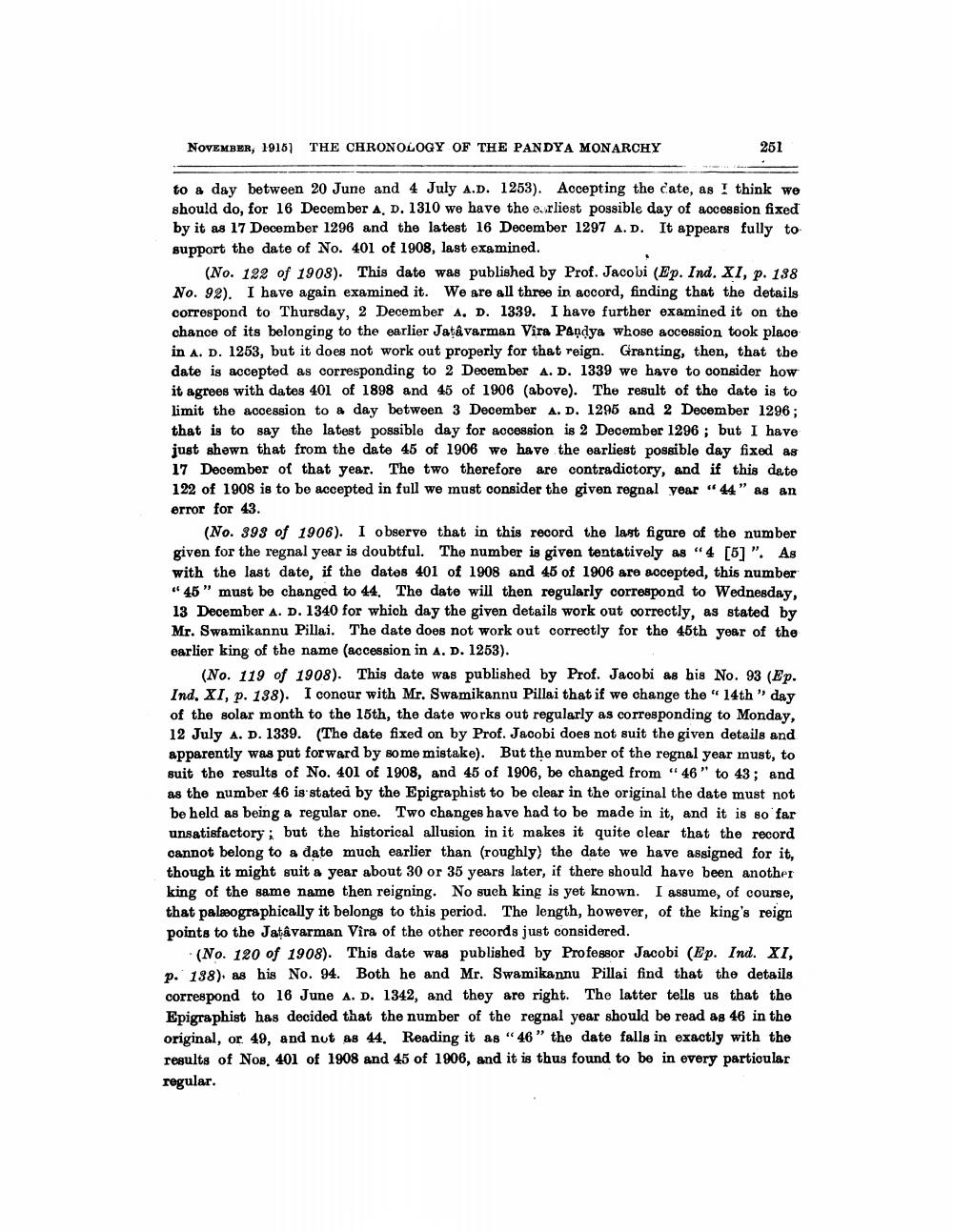________________
NOVEMBER, 1915) THE CHRONOLOGY OF THE PANDYA MONARCHY
251
-
to a day between 20 June and 4 July A.D. 1253). Accepting the cate, as ! think we should do, for 16 December A, D. 1310 we have the erliest possible day of accession fixed by it as 17 December 1296 and the latest 16 December 1297 A.D. It appears fully to support the date of No. 401 of 1908, last examined.
(No. 122 of 1908). This date was published by Prof. Jacobi (Ep. Ind. XI, p. 138 No. 92). I have again examined it. We are all three in accord, finding that the details correspond to Thursday, 2 December A, D. 1339. I have further examined it on the chance of its belonging to the earlier Jatavarman Vira Pandya whose accession took place in A. D. 1253, but it does not work out properly for that reign. Granting, then, that the date is accepted as corresponding to 2 December A.D. 1339 we have to consider how it agrees with dates 401 of 1898 and 45 of 1906 (above). The result of the date is to limit the acoession to & day between 3 December A.D. 1298 and 2 December 1296: that is to say the latest possible day for accession is 2 December 1296 ; but I have just shown that from the date 45 of 1906 we have the earliest possible day fixed as 17 December of that year. The two therefore are contradictory, and if this date 122 of 1908 is to be accepted in full we must consider the given regnal year "44" as an error for 43.
(No. 398 of 1906). I observe that in this record the last figure of the number given for the regnal year is doubtful. The number is given tentatively as "4 [6] ". As with the last date, if the dates 401 of 1908 and 46 of 1906 are accepted, this number "45" must be changed to 44. The date will then regularly correspond to Wednesday, 13 December A. D. 1340 for which day the given details work out correctly, as stated by Mr. Swamikannu Pillai. The date does not work out correctly for the 45th year of the earlier king of the name (accession in A. D. 1253).
(No. 119 of 1908). This date was published by Prof. Jacobi as his No. 93 (Ep. Ind. XI, p. 138). I concur with Mr. Swamikannu Pillai that if we change the " 14th day of the solar month to the 15th, the date works out regularly as corresponding to Monday, 12 July A. D. 1339. (The date fixed on by Prof. Jacobi does not suit the given details and apparently was put forward by some mistake). But the number of the regnal year must, to suit the results of No. 401 of 1908, and 45 of 1906, be changed from " 46" to 43: and as the number 46 is stated by the Epigraphist to be clear in the original the date must not be held as being a regular one. Two changes have had to be made in it, and it is so far unsatisfactory; but the historical allusion in it makes it quite clear that the record cannot belong to a date much earlier than (roughly) the date we have assigned for it, though it might suit a year about 30 or 35 years later, if there should have been another king of the same name then reigning. No such king is yet known. I assume, of course, that palæographically it belongs to this period. The length, however, of the king's reign points to the Jatâvarman Vira of the other records just considered.
(No. 120 of 1908). This date was published by Professor Jacobi (Ep. Ind. XI, p. 188). as his No. 94. Both he and Mr. Swamikannu Pillai find that the details correspond to 16 June A. D. 1342, and they are right. The latter tells us that the Epigraphist has decided that the number of the regnal year should be read as 46 in the original, or 49, and nut as 44. Reading it as " 46" the date falls in exactly with the results of Nos. 401 of 1908 and 45 of 1906, and it is thus found to be in every particular regular.




